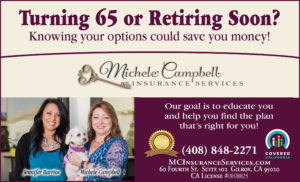Your Insurance … with Michele Campbell – Life insurance protection to take care of your family is affordable
Published in the July 11 – July 24, 2018 issue of Gilroy Life
 Many Gilroyans don’t have life insurance because they think they can’t afford it or don’t need it. If you have a living family member, then you need it. Don’t leave them holding the bag of your funeral costs. You don’t need much, and it doesn’t cost that much for a small policy.
Many Gilroyans don’t have life insurance because they think they can’t afford it or don’t need it. If you have a living family member, then you need it. Don’t leave them holding the bag of your funeral costs. You don’t need much, and it doesn’t cost that much for a small policy.
Life Insurance You Don’t Have to Die to Use!
The whole idea of life insurance is to give you and your loved one’s peace of mind. It feels good to have a sense of security knowing your loved ones are going to be taken care of if something happens to you.
But what if something happens to you and you don’t die? What if you suffer a major heart attack, stroke, or invasive cancer and don’t die? Would you be able to maintain your standard of living if you were financially impacted by a serious illness? If you’re self-employed, would you be able to continue to pay your personal bills and business expenses?
Traditional life insurance is designed to provide security for your loved ones in the event of your premature death … but what if you could get life insurance you don’t have to die to use? What if you could build up cash value in your policy and use it as additional retirement income? There are different types of life insurance and different ways to structure a policy when it’s set up, to achieve the results that are optimum for you.
Accelerated Benefit Riders can be added to the policy when you apply or are often already built into the policy. Newer plans are often including these riders at no extra charge. If some of the above situations happen to you while insured, you can receive a payout of a portion or most of the amount you are insured for, called the face amount, and when received it is tax free income to you. This money can help tremendously during a very stressful time, allowing you to focus on healing instead of worrying about how you’re going to pay your bills.
Here’s an example of the three common riders: (The descriptions can vary slightly with each insurance company.)
Chronic Illness: This rider allows the owner to accelerate some or all of the insured person’s base life insurance benefit in the event the insured is diagnosed with a chronic illness or condition. To qualify for benefits under the Chronic Illness Rider, the insured must be diagnosed with a chronic illness, which is an illness or physical condition that was initially certified by a licensed health care practitioner within the past 12 months and affects the insured person so that he or she: 1) Is unable to perform at least two Activities of Daily Living (ADLs); or 2) Requires substantial supervision by another person to protect the insured person from threats to health and safety due to severe cognitive impairment.
ADLs: bathing, dressing, toileting, transferring, continence, eating
Critical Illness: This rider allows the owner to accelerate some or all of the insured person’s base life insurance benefit in the event the insured is diagnosed with a critical illness or condition. A critical illness or condition is defined as one of the following: heart attack, major organ transplant, stroke, invasive cancer, blindness, end stage renal (kidney) failure, paralysis, Amyotrophic Lateral Sclerosis (ALS-or Lou Gehrig’s disease).
Terminal Illness: This rider allows the owner to accelerate some or all of the insured person’s base life insurance benefit in the event the insured is diagnosed with a terminal illness. A terminal illness is defined as an illness or physical condition that is certified by a physician to be reasonably expected to result in the insured’s death within 24 months from the date of certification.
There are various ways to structure the policy, so the best idea is to talk with an insurance professional about your situation to help determine the amount of insurance and the way to structure it.
- Your Medicare … with Michele Campbell: It’s important to understand the details of Medicare enrollment periods - August 9, 2023
- Your Insurance … with Michele Campbell: Are you retiring or new to Medicare? - December 14, 2022
- Your Medicare … with Michele Campbell: Open enrollment is coming soon - September 23, 2022
